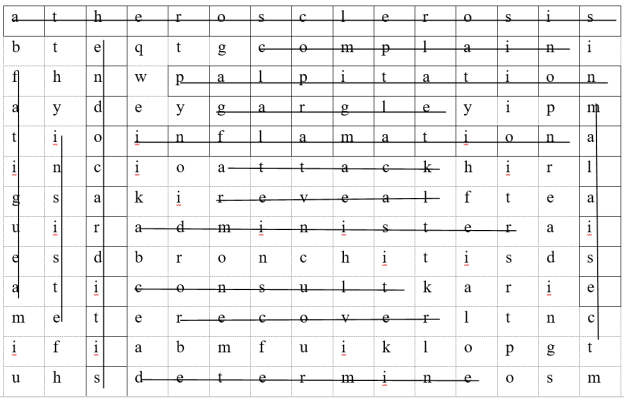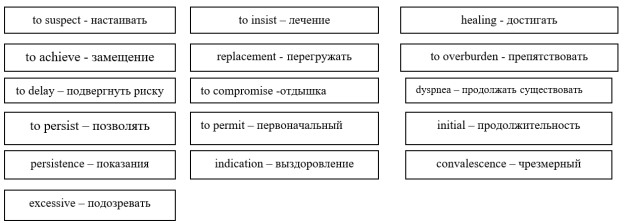The theme of the lesson: “Cardiovascular diseases (Myocardial infarction)”
The aim of the lesson: to systematize knowledge of the theme “Myocardial infarction”.
Tasks: to learn some information about myocardial infarction; to develop working skills in group; to develop listening comprehension; to develop memory and creative imagination.
Method: TBL (Team Based Learning)
Equipment: whiteboard; laptop; cards with emblems; CD-disc with the video “Myocardial infarction”, “Heart attack”; Copies with the questions to the video; Cards for game “Domino”, “Find out words on the theme”; Pieces of paper and chalk; Score table.
1. An organizational moment.
Aim: revision of the words on the topics “Diseases” and “Heart”.
There are cards with words on the topics “Diseases” and “Heart”. Each student chooses one card, reads the word and takes place where he/she sees a card with his/her emblem — “Diseases” / “Heart”.
Cards:

The result: students are divided into two teams and involved in the process of the lesson.
2. Check up knowledge of new vocabulary on the topic “Diseases of cardiovascular system”.
Aim: revising previously taught vocabulary.
It is used game tasks “Domino” and “Find out”.
Game “Find out”
Find and circle the words connected with medicine and fill in the table

Find out:
|
Diseases of cardiovascular system |
symptoms |
What doctors do |
What patients do |
|
Atherosclerosis Endocarditis |
a palpitation, a malaise a fatigue, an attack an inflammation |
to insist, to administer to determine, to reveal
|
to complain, to consult, to recover |
Vocabulary Domino
Students should match the word on the right of each domino with the word on the left of another domino to form pairs “English word — Russian word”. The pair or the group who can put all the dominoes correctly in the shortest period of time wins the game.
Cards:

The result: consolidation of new vocabulary (its meaning and writing).
3. Reading the text “Myocardial infarction” and answer the questions to this text.
Aim: to give students practice at reading for specific information.
Myocardial infarction
Whenever the diagnosis of recent myocardial infarction is made or even suspected, it is the physician’s duty to insist that the patient should be put to bed. He must remain at absolute rest until state of healing of the infarcted area has been achieved. There should hardly be any compromise with this program, particularly during the first two or three weeks, for it is during this period that the damaged muscle is undergoing necrosis and gradual replacement by fibrous tissue.
Overburdening of the heart by unnecessary effort may delay healing or cause rupture of the myocardium and death. Good nursing is a valuable adjunct.
The period of absolute rest is quite variable. In cases in which the symptoms have been minimal, the temperature and leukocyte count have been only slightly elevated and have returned to normal within a few days and there is no tachycardia or dyspnea, gradually increasing ambulation may be permitted alter four or five weeks in bed. Tachycardia — excessive rapidity of heart’s action. When the initial shock has been more severe and the abnormal findings have persisted for a longer period, caution should be observed in allowing the patient to get out of bed until there has been a rest period of six or eight weeks.
The persistence of fever, leukocytosis, increased sedimentation rate, tachycardia, dyspnea and chest pain is an indication that the period of bed rest should be considerably extended.
After the patient has become ambulatory, the increase in activity should be very gradual. This may require a further period of convalescence of three to ix or nine months.
The questions to the text “Myocardial infarction”:
- What is the physician's duty, if the diagnosis of recent myocardial infarction is made or even suspected?
- How long must the patient with myocardial infarction remain at absolute rest?
- In what period does the damaged muscle undergo necrosis and gradual replacement by fibrous tissue?
- What may delay healing or cause rupture of the myocardium and death?
- What is a valuable adjunct by treatment of myocardial infarction?
- How can you characterize the period of absolute rest by the patient with myocardial infarction?
- In what case may be gradually increasing ambulation permitted patient with myocardial infarction?
- In what case should the patient with myocardial infarction be put to bed for a period of six or eight weeks?
- In what case should the physician considerably extend the period of bed rest for the patient with myocardial infarction?
- Characterize the increase in activity for the patient with myocardial infarction, after he has become ambulatory.
Students prepare answers to these questions, and then they choose who will answer. One student chooses the student from other team. (He/she says the number of the question and student’s name).
The result: students develop skills at reading for specific information
4. Watching video “Myocardial infarction”.
Aim: to develop listening skills.
The duration of video is not more than 2 minutes. It is possible to download the video on this topic per web-site www.google.ru. It is necessary to make up 8 or 10 questions to the downloaded video. At first, students get cards with the questions to the video, look through these questions and teacher asks them what information they expect to gain from this video (students predict the content of the video). Then after the first watching the video they say who is right. After the second watching video students answer the questions to this video.
The result: students practice at listening for detailed comprehension.
5. Making up comments to the video “Heart attack”
Aim: to teach to use new vocabulary in practice
Students watch video “Heart attack” without words. Their task is to make up comments to this video. They have cards with words and word combinations which they can use in their comments.
Card “Words and word combinations to video”
To be responsible for; to provide; cholesterol plaque; to form; the side of the artery; reduce;
blood flow; to attach; to block; blood flow; the heart attack; to occur; to pump; properly;
to decline; the accumulation of fat in the arterial walls; to carry oxygen to the heart become; unstable; dying heart tissue
Symptoms: shortness of breath, weakness, palpitation, fatigue, chest pain, nausea, vomiting, heart murmurs, irregular heart attack
Risk factors: lack of physical activity, alcohol, age, obesity, sex-men are more at risk than women, diabetes, high blood pressure, smoking, family history of heart disease at a young age, elevated cholesterol level.
Then one student from each team goes to the whiteboard, watches video and makes his comments.
The result: to provide students with freer practice at using target language
6. Make up dialogue on the theme “At the cardiologist’s”
Aim: to develop students’ communicative skills
The last task is to make up the dialogue on the theme “At the cardiologist’s” and to act it. Students have cards with words and word combinations which they can use in their dialogues.
Card “The dialogue on the theme “At the cardiologist’s”
What are the main symptoms that you suffer; to look at; listen to; Come closer; take off your shirt; to cancel work for a week; to stay in bed; It's also necessary….; to prescribe; to cause pain; to describe the main symptoms; to get all the test results; As to the tests, everything is okay.; Your cardiogram is normal; The X-ray shows…; the result of..; to be caused by…; It could become extremely serious; to worry about your health; to advise; to examine; to take a deep breath; to test your blood pressure.
The result: students practice in questioning the patient on his health and prescribing the patient the treatment.







